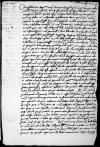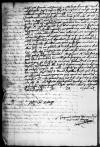Letter #2658
Ioannes DANTISCUS to [Sigmund von HERBERSTEIN]Heilsberg (Lidzbark Warmiński), 1543-08-17
English register:
Dantiscus received Herberstein’s letter sent from Vienna on June 6. He justifies his being unable to comfort the younger Polish queen, Elizabeth von Habsburg, with conversation: he has left Cracow (June 1). He describes the intrigues of Bona Sforza, the elder queen of Poland aimed at hindering his communication with Queen Elizabeth. As Herberstein wished, he has written to Queen Elizabeth. He has also reminded Sigismund I, the elder king of Poland, in a letter about the conversation concerning Queen Elizabeth that he had with him in private before he left. He describes King Sigismund I’s fatherly kindness towards Elizabeth.
Dantiscus says that Herberstein’s resentment over the ungratefulness of Queen Bona (for services rendered in elevating her to the royal status) is shared by many, and that it is dangerous to write about it. That is also why he is not replying to some other issues raised in Herberstein’s letter.
Dantiscus mentions that Herberstein visited him with Niklas II zu Salm when he was lying ill in Cracow. He informs him that he has recovered his health. He reminds Herberstein that he was to give his excuses to King Ferdinand I: that because of illness he had been unable to deal with the matters entrusted to him in the letter delivered by Herberstein, and that he had failed to reply to it. He asks that Herberstein commend him to Ferdinand I’s attention and express his gratitude for previous favors. He encloses a copy of news received from Gdańsk, which he recently sent to Queen Bona. He asks Herberstein to write to him about current events and to send his reply through Seweryn Boner, to whom he is entrusting the present letter.
Manuscript sources:
Prints:
| ||||||
Text & apparatus & commentary Plain text Text & commentary Text & apparatus Excerpts concerning Dantiscus' travels
Clarissime ac Magnifice Domine, amice carissime plurimumque honorande. Salutem diuturnissimam omniumque fortunarum et dignitatum Magnificentiae Vestrae accessionem precor ex animo.
Quae me suis cf.
Datae
Magnificentiae Vestrae deditissimus
[] The terms of her marriage to Sigismund II Augustus were agreed, with Herbersteins involvement, at the congress in Poznań in 1530 (cf.
[1 ] For more about the kind and fatherly attitude of Sigismund I towards his daughter-in-law, see Jagiellonki, I, p. 112, 133-135; Jagiellonki, V, Additions II, No. 8, p. 27-28
[2 ] A reference to Herberstein’s involvement in bringing about the marriage between Sigismund I and Bona Sforza d’Aragona (see cf.
[3 ] Niklas II, count of Salm and Neuburg (d. after 1551), imperial secret counsellor and Oberstkämmerer – high chamberlain (up to 1550/1551). In 1533, as an envoy of Ferdinand I, he went to Emperor Charles V and pope Clement VII to settle the matter of returning Koróni to Turkey. Knight of the Order of the Golden Fleece (1533), commander-in-chief of the forces in Hungary ( Generalfeldhauptmann in Ungarn ), and in 1547-1550 commander-in-chief of the forces in Lower Austria ( Oberbefehlshaber an der niederösterreichischen Grenze ) (KF, III, No. 678a, p. 665, KF, IV, p. 29, No. 715, p. 114-115, No. 718, p. 123; AT, XV, No. 159, p. 224; cf. Elementa, XLVIII, No. 380, p. 138-140, No. 406, Annexum II, p. 191, No. 416, Annexum VIII, p. 223, Annexum X, p. 225; Herberstein 1560, f. D4v; Herberstein 1855, p. 329, 331, 334, 336-337, 360, 381; cf. Pociecha, IV, p. 167; Kohler II, p. 145)
[4 ] Cf. cf.
[5 ] After Elizabeth von Habsburg’s marriage to Sigismund II Augustus and her coronation (May 6, 1543), the wedding celebrations and accompanying events linked to the stay of foreign envoys continued for the next three weeks in Cracow (see cf.
[6 ] See cf.
[7 ] Most likely a reference to the fair marking the feast of St. Dominic (August 8), held next to the Dominican Fathers’ church in Gdańsk from the 13th century, to which merchants from the Baltic countries came in great numbers
[8 ] The novitates enclosed with the mentioned letter is not known. Herberstein refers to its content in cf.

